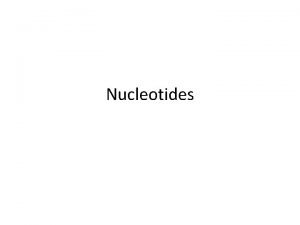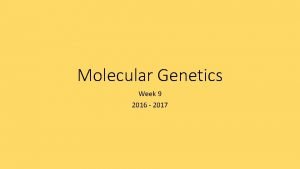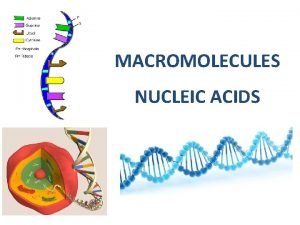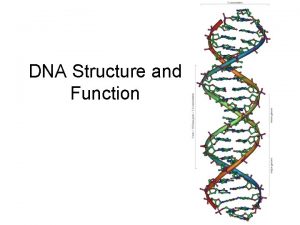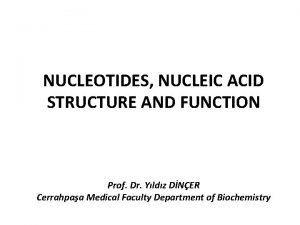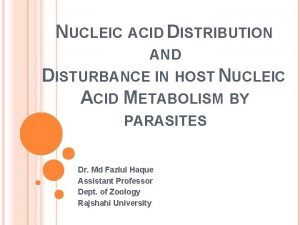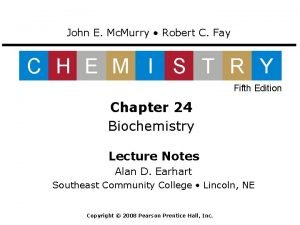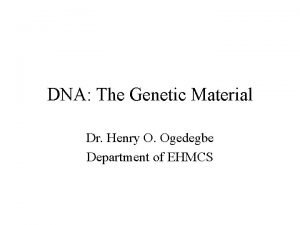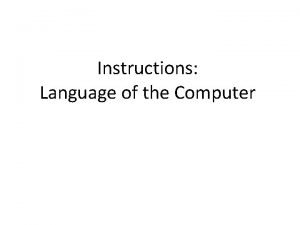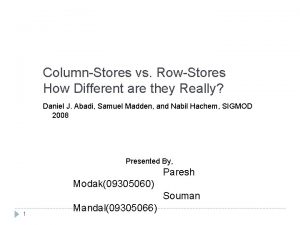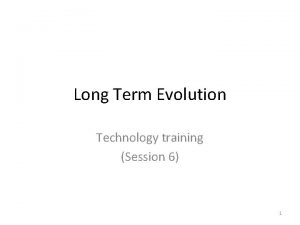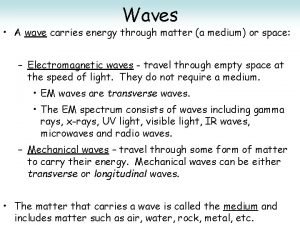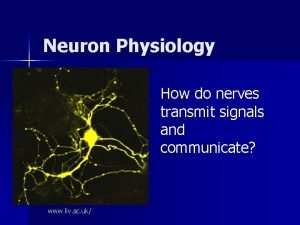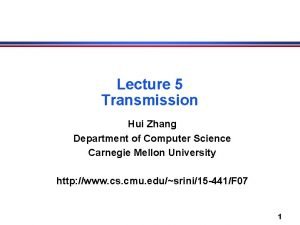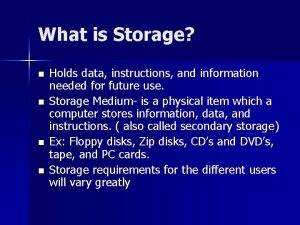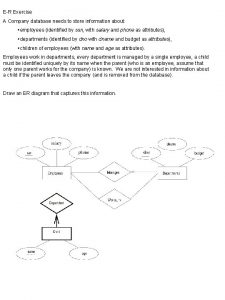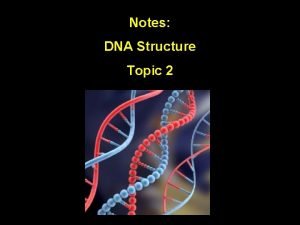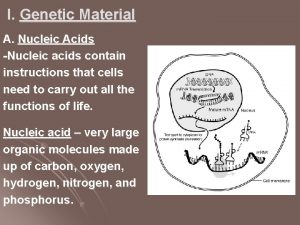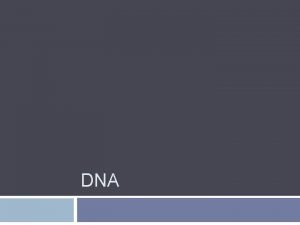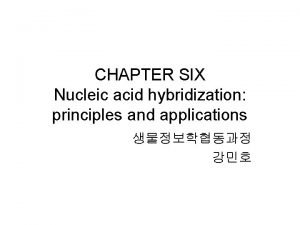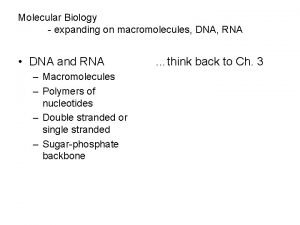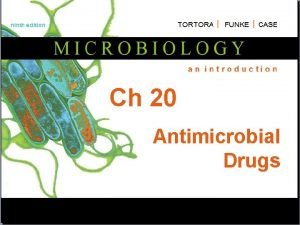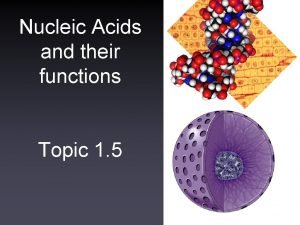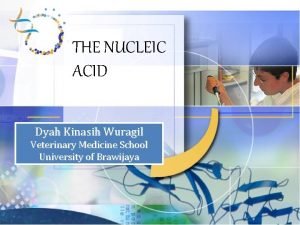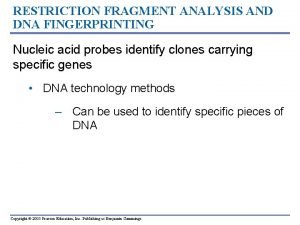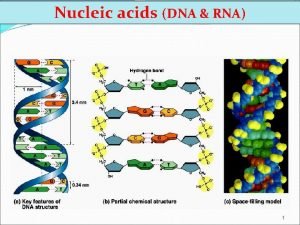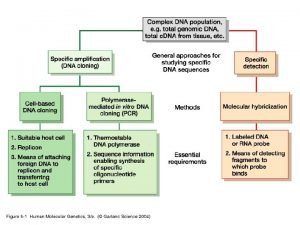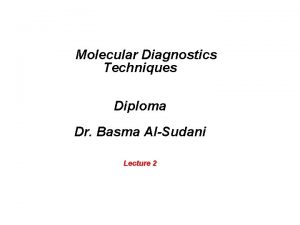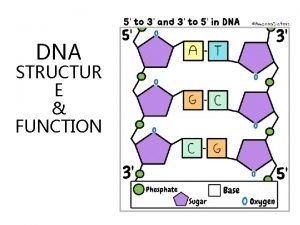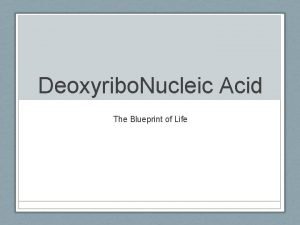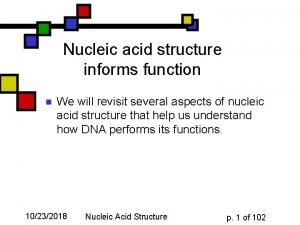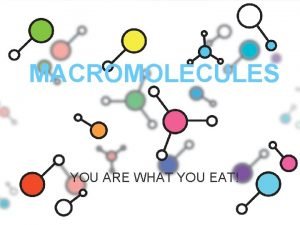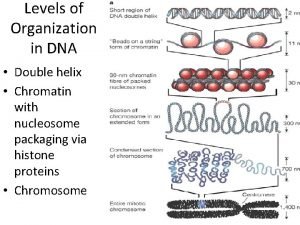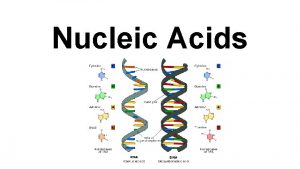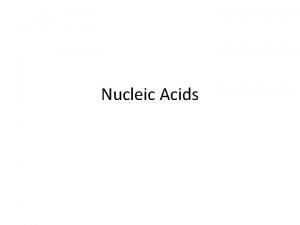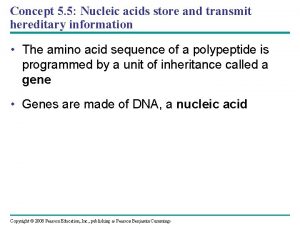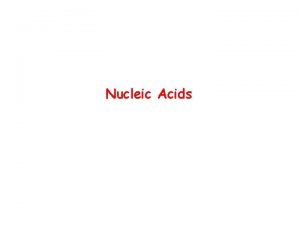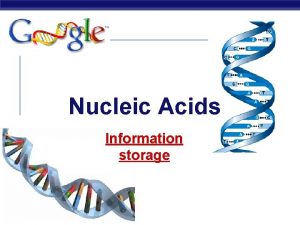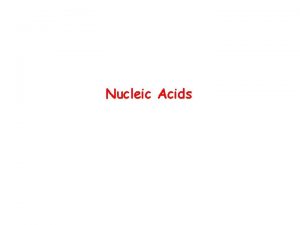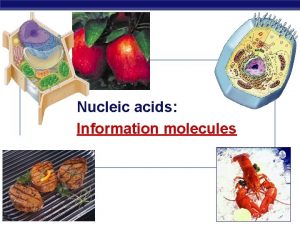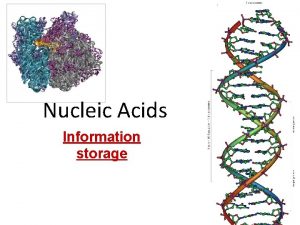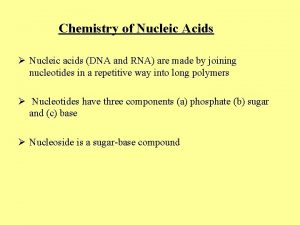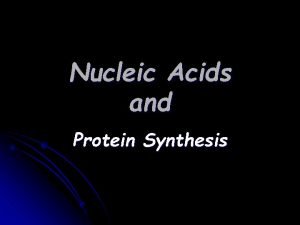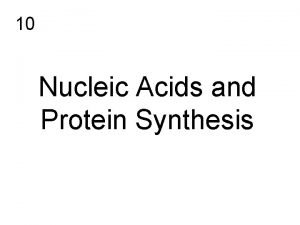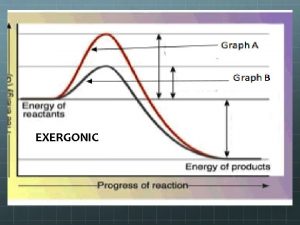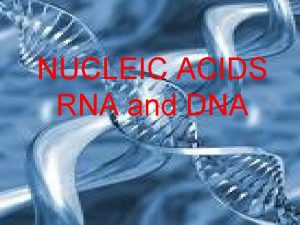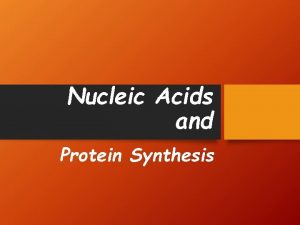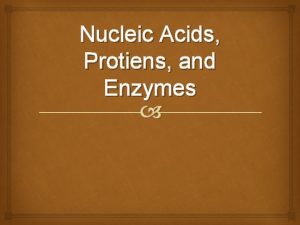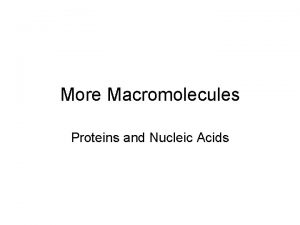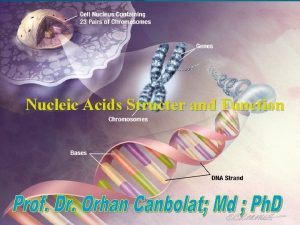Nucleic acids store and transmit information The instructions

















































































- Slides: 81

Nucleic acids store and transmit information The instructions your cells use to make specific proteins are encoded in genes Genes are made of DNA, a nucleic acid Copyright © 2008 Pearson Education, Inc. , publishing as Pearson Benjamin Cummings

The Roles of Nucleic Acids There are two types of nucleic acids: Deoxyribonucleic acid (DNA) Ribonucleic acid (RNA) DNA provides directions for its own replication DNA directs synthesis of RNA, which directs synthesis of proteins To synthesize something = to make it Copyright © 2008 Pearson Education, Inc. , publishing as Pearson Benjamin Cummings

Fig. 5 -26 -1 DNA 1 Synthesis of m. RNA in the nucleus m. RNA NUCLEUS CYTOPLASM

Fig. 5 -26 -2 DNA 1 Synthesis of m. RNA in the nucleus m. RNA NUCLEUS CYTOPLASM m. RNA 2 Movement of m. RNA into cytoplasm via nuclear pore

Fig. 5 -26 -3 DNA 1 Synthesis of m. RNA in the nucleus m. RNA NUCLEUS CYTOPLASM m. RNA 2 Movement of m. RNA into cytoplasm via nuclear pore Ribosome 3 Synthesis of protein Polypeptide Amino acids

The Structure of Nucleic Acids Nucleic acids are polymers called polynucleotides Each polynucleotide is made of monomers called nucleotides Each nucleotide consists of a nitrogenous base, a pentose sugar, and a phosphate group Copyright © 2008 Pearson Education, Inc. , publishing as Pearson Benjamin Cummings

Fig. 5 -27 ab 5' end 5'C 3'C Nucleoside Nitrogenous base 5'C Phosphate group 5'C 3' end 3'C Sugar (pentose) (b) Nucleotide with its 3 parts: A pentose (5 -sided) sugar, a nitrogenous base, and a phosphate group. (a) Polynucleotide, or nucleic acid

Fig. 5 -27 c-1 Nitrogenous bases Pyrimidines Cytosine (C) Thymine (T, only in DNA) Uracil (U, only in RNA) Purines Adenine (A) Guanine (G) (c) Nucleotide components: nitrogenous bases C, A, and G bases are found in both DNA and RNA.

Fig. 5 -27 c-2 Sugars Deoxyribose (in DNA) Ribose (in RNA) (c) Nucleotide components: sugars

The DNA Double Helix A DNA molecule has two polynucleotides spiraling around an imaginary axis, forming a double helix The DNA double helix is antiparallel – means one strand is upside down compared to the other. The nitrogenous bases in DNA pair up and form hydrogen bonds: adenine (A) always pairs with thymine (T), and guanine (G) always with cytosine (C) Copyright © 2008 Pearson Education, Inc. , publishing as Pearson Benjamin Cummings

Fig. 5 -28 5' end 3' end Sugar-phosphate backbones Base pair (joined by hydrogen bonding) Old strands Nucleotide about to be added to a new strand 3' end 5' end New strands 5' end 3' end

DNA and Proteins as Tape Measures of Evolution The sequences of nucleotides in DNA molecules are passed from parents to offspring Two closely related organisms or species are more similar in DNA than are more distantly related species How DNA instructions work: the basic idea AATGCTG would make a different protein than TATTGGA. The order of the nitrogenous bases is a code that tells how to make each protein. Copyright © 2008 Pearson Education, Inc. , publishing as Pearson Benjamin Cummings

How do we know about DNA? Since Ancient Greece, people have speculated about how we inherit traits from our parents Early in the 20 th century, one of the biggest questions in biology was this: What kinds of molecules determine what traits we get from our parents, and how? Copyright © 2008 Pearson Education Inc. , publishing as Pearson Benjamin Cummings

The Search for the Genetic Material For many years, DNA and proteins were considered the two possible options for the genetic molecule. Many scientists favored proteins because there were so many different kinds Copyright © 2008 Pearson Education Inc. , publishing as Pearson Benjamin Cummings

Evidence That DNA Can Transform Bacteria The discovery of the genetic role of DNA began with research by Frederick Griffith in 1928 Griffith worked with two strains of a bacterium, one pathogenic (disease-causing) and one harmless Copyright © 2008 Pearson Education Inc. , publishing as Pearson Benjamin Cummings

Fig. 16 -2 Mixture of heat-killed Living S cells Living R cells Heat-killed S cells and (control) S cells (control) living R cells EXPERIMENT RESULTS Mouse dies Mouse healthy Mouse dies Living S cells

In 1944, Oswald Avery, Maclyn Mc. Carty, and Colin Mac. Leod announced that the transforming substance was DNA Their experiments showed that only DNA (and not proteins) worked in transforming harmless bacteria into pathogenic bacteria Many biologists remained skeptical, mainly because little was known about DNA Copyright © 2008 Pearson Education Inc. , publishing as Pearson Benjamin Cummings

Evidence That Viral DNA Can Program Cells More evidence for DNA as the genetic material came from studies of viruses that infect bacteria, called bacteriophages (or phages). Copyright © 2008 Pearson Education Inc. , publishing as Pearson Benjamin Cummings

Fig. 16 -3 Phage head Tail sheath Tail fiber Bacterial cell 100 nm DNA

In 1952, Alfred Hershey and Martha Chase performed experiments showing that DNA is the genetic material of a phage known as T 2 Whatever the phage injected into the host E. coli cell transformed that cell, causing it to make more phages Copyright © 2008 Pearson Education Inc. , publishing as Pearson Benjamin Cummings

Fig. 16 -4 -1 EXPERIMENT Phage Radioactive protein Bacterial cell Batch 1: radioactive sulfur (35 S) DNA Radioactive DNA Batch 2: radioactive phosphorus ( 32 P)

Fig. 16 -4 -2 EXPERIMENT Phage Empty protein Radioactive shell protein Bacterial cell Batch 1: radioactive sulfur (35 S) DNA Phage DNA Radioactive DNA Batch 2: radioactive phosphorus ( 32 P)

Fig. 16 -4 -3 EXPERIMENT Phage Empty protein Radioactive shell protein Radioactivity (phage protein) in liquid Bacterial cell Batch 1: radioactive sulfur (35 S) DNA Phage DNA Centrifuge Pellet (bacterial cells and contents) Radioactive DNA Batch 2: radioactive phosphorus ( 32 P) Centrifuge Pellet Radioactivity (phage DNA) in pellet

Additional Evidence That DNA Is the Genetic Material • It was known that DNA is a polymer of nucleotides, each consisting of a nitrogenous base, a sugar, and a phosphate group • In 1950, Erwin Chargaff reported that DNA composition varies from one species to the next • This evidence of diversity made DNA a more credible candidate for the genetic material Copyright © 2008 Pearson Education Inc. , publishing as Pearson Benjamin Cummings

Chargaff’s Rules Chargaff noticed that: amount of Adenine (A) = amount of thymine (T) amount of cytosine (C) = amount of guanine (G) If a species has 42% Adenine bases, what percent of its bases are Cytosine?

Fig. 16 -5 Sugar–phosphate backbone 5 end Nitrogenous bases Thymine (T) Adenine (A) Cytosine (C) DNA nucleotide Phosphate Sugar (deoxyribose) 3 end Guanine (G)

Building a Structural Model of DNA: Scientific Inquiry After most biologists became convinced that DNA was the genetic material, the challenge was to determine how its structure accounts for its role Maurice Wilkins and Rosalind Franklin were using a technique called X-ray crystallography to study molecular structure Franklin produced a picture of the DNA molecule using this technique Copyright © 2008 Pearson Education Inc. , publishing as Pearson Benjamin Cummings

Fig. 16 -6 (a) Rosalind Franklin (b) Franklin’s X-ray diffraction photograph of DNA

Franklin’s X-ray crystallographic images of DNA enabled Watson to deduce that DNA was a double helix The X-ray images also enabled Watson to deduce the width of the helix and the spacing of the nitrogenous bases Copyright © 2008 Pearson Education Inc. , publishing as Pearson Benjamin Cummings

Fig. 16 -1

Watson and Crick built models of a double helix to conform to the X-rays and chemistry of DNA Franklin had concluded that there were two antiparallel sugar-phosphate backbones, with the nitrogenous bases paired in the molecule’s interior Copyright © 2008 Pearson Education Inc. , publishing as Pearson Benjamin Cummings

Fig. 16 -7 a 5 end Hydrogen bond 3 end 1 nm 3. 4 nm 3 end 0. 34 nm (a) Key features of DNA structure (b) Partial chemical structure 5 end

Fig. 16 -7 b (c) Space-filling model

At first, Watson and Crick thought the bases paired like with like (A with A, and so on), but such pairings did not result in a uniform width Instead, pairing a purine with a pyrimidine (A with T and C with G) resulted in a uniform width consistent with the X-ray Copyright © 2008 Pearson Education Inc. , publishing as Pearson Benjamin Cummings

Fig. 16 -UN 1 Purine + purine: too wide Pyrimidine + pyrimidine: too narrow Purine + pyrimidine: width consistent with X-ray data

Fig. 5 -27 c-1 Nitrogenous bases Pyrimidines Cytosine (C) Thymine (T, only in DNA) Uracil (U, only in RNA) Purines Adenine (A) Guanine (G) (c) Nucleotide components: nitrogenous bases C, A, and G bases are found in both DNA and RNA.

Watson and Crick reasoned that the pairing was more specific, dictated by the base structures They determined that adenine (A) paired only with thymine (T), and guanine (G) paired only with cytosine (C) The Watson-Crick model explains Chargaff’s rules: in any organism the amount of A = T, and the amount of G = C Copyright © 2008 Pearson Education Inc. , publishing as Pearson Benjamin Cummings

Fig. 16 -8 Adenine (A) Thymine (T) Guanine (G) Cytosine (C)

The Basic Principle: Base Pairing to a Template Strand Watson and Crick noted that the specific base pairing suggested a possible copying mechanism for genetic material Since the two strands of DNA are complementary (one kind of base only pairs with one other kind of base), each strand acts as a template for building a new strand in replication Copyright © 2008 Pearson Education Inc. , publishing as Pearson Benjamin Cummings

Fig. 16 -9 -1 A T C G T A A T G C (a) Parent molecule

Fig. 16 -9 -2 A T C G T A A T G C (a) Parent molecule (b) Separation of strands

Fig. 16 -9 -3 A T A T C G C G T A T A T G C G C (a) Parent molecule (b) Separation of strands (c) “Daughter” DNA molecules, each consisting of one parental strand one new strand What is the sequence of nitrogenous bases that is complementary to the strand “AAGTAC”?

DNA Replication: A Closer Look The copying of DNA is remarkable in its speed and accuracy More than a dozen enzymes and other proteins participate in DNA replication Copyright © 2008 Pearson Education Inc. , publishing as Pearson Benjamin Cummings

Getting Started Replication begins at special sites called origins of replication, where the two DNA strands are separated, opening up a replication “bubble” A eukaryotic chromosome may have hundreds or even thousands of origins of replication; a prokaryotic chromosome has only one Replication proceeds in both directions from each origin, until the entire molecule is copied Copyright © 2008 Pearson Education Inc. , publishing as Pearson Benjamin Cummings

Fig. 16 -12 a Origin of replication Prokaryotic DNA replication Parental (template) strand Daughter (new) strand Doublestranded DNA molecule Replication fork Replication bubble 0. 5 µm Two daughter DNA molecules (a) Origins of replication in E. coli

Fig. 16 -12 b Eukaryotic DNA replication Origin of replication Double-stranded DNA molecule Parental (template) strand Daughter (new) strand 0. 25 µm Bubble Replication fork Two daughter DNA molecules (b) Origins of replication in eukaryotes

At the end of each replication bubble is a replication fork, a Y-shaped region where new DNA strands are elongating Helicases are enzymes that untwist the double helix at the replication forks Single-strand binding protein binds to and stabilizes single-stranded DNA until it can be used as a template Topoisomerase corrects “overwinding” ahead of replication forks by breaking, swiveling, and rejoining DNA strands Copyright © 2008 Pearson Education Inc. , publishing as Pearson Benjamin Cummings

Fig. 16 -13 Primase Single-strand binding proteins 3 Topoisomerase 5 3 5 Helicase 5 RNA primer 3

DNA polymerases cannot initiate (begin) synthesis of a polynucleotide; they can only add nucleotides to the 3 end of another nucleotide. The initial nucleotide strand is a short RNA primer Have you ever painted something with primer? What is it used for? Copyright © 2008 Pearson Education Inc. , publishing as Pearson Benjamin Cummings

An enzyme called primase can start an RNA chain from scratch and adds RNA nucleotides one at a time using the parental DNA as a template The primer is short (5– 10 nucleotides long), and the 3 end serves as the starting point for the new DNA strand Since it is made of RNA, the primer has U’s instead of T’s Copyright © 2008 Pearson Education Inc. , publishing as Pearson Benjamin Cummings

Synthesizing a New DNA Strand Enzymes called DNA polymerases catalyze the elongation of new DNA at a replication fork Most DNA polymerases require a primer and a DNA template strand The rate of elongation is about 500 nucleotides per second in bacteria and 50 per second in human cells – that’s fast! Copyright © 2008 Pearson Education Inc. , publishing as Pearson Benjamin Cummings

Each nucleotide that is added to a growing DNA strand is a nucleoside triphosphate (a d. NTP) d. ATP supplies adenine to DNA and is similar to the ATP of energy metabolism The difference is in their sugars: d. ATP has deoxyribose while ATP has ribose As each monomer of d. ATP joins the DNA strand, it loses two phosphate groups We also have d. CTP, d. GTP, and d. TTP (which have different nitrogenous bases). Copyright © 2008 Pearson Education Inc. , publishing as Pearson Benjamin Cummings

Fig. 16 -14 New strand 5 end Sugar 5 end 3 end T A T C G G C T A A Base Phosphate Template strand 3 end DNA polymerase 3 end A T Pyrophosphate 3 end C Nucleoside triphosphate 5 end C 5 end

DNA polymerases add nucleotides only to the free 3 end of a growing strand; therefore, a new DNA strand can elongate only in the 5 to 3 direction Along one template strand of DNA, the DNA polymerase synthesizes a leading strand continuously, moving toward the replication fork Copyright © 2008 Pearson Education Inc. , publishing as Pearson Benjamin Cummings

Fig. 16 -15 a Overview Origin of replication Leading strand Lagging strand Primer Leading strand Lagging strand Overall directions of replication

Fig. 16 -15 b Origin of replication 3 5 RNA primer 5 “Sliding clamp” 3 5 Parental DNA pol III 3 5 5 3 5

To elongate the other new strand, called the lagging strand, DNA polymerase must work in the direction away from the replication fork The lagging strand is synthesized as a series of segments called Okazaki fragments, which are joined together by DNA ligase Animation: Lagging Strand Copyright © 2008 Pearson Education Inc. , publishing as Pearson Benjamin Cummings

Fig. 16 -16 a Overview Origin of replication Leading strand Lagging strand 2 1 Leading strand Overall directions of replication

Fig. 16 -16 b 1 3 Template strand 5 5 3

Fig. 16 -16 b 2 3 Template strand 3 5 5 RNA primer 5 3 1 3 5 DNA Polymerase III Adds nucleotides to the primer, forming an Okazaki fragment

Fig. 16 -16 b 3 3 Template strand 3 5 5 RNA primer 5 3 3 1 Okazaki fragment 3 1 5 5 3 5 DNA Polymerase III Adds nucleotides to the primer, forming an Okazaki fragment

Fig. 16 -16 b 4 3 5 5 Template strand 3 RNA primer 5 3 1 5 3 5 Okazaki fragment 3 3 3 1 5 5 2 1 3 5 DNA Polymerase III Adds nucleotides to the primer, forming an Okazaki fragment

Fig. 16 -16 b 5 3 5 5 Template strand 3 RNA primer 5 3 1 3 5 1 5 DNA Polymerase III Adds nucleotides to the primer, forming an Okazaki fragment 5 2 3 5 Okazaki fragment 3 3 3 1 3 5 5 2 1 3 5 DNA Polymerase I Replaces the primer with DNA, adding to the 3’ end of the fragment

Fig. 16 -16 b 6 3 5 5 Template strand 3 RNA primer 5 3 1 3 5 1 5 DNA ligase 2 3 DNA Polymerase III Adds nucleotides to the primer, forming an Okazaki fragment 5 2 Binds the fragments together 3 5 1 5 3 5 Okazaki fragment 3 3 3 3 5 1 5 2 1 Overall direction of replication 3 5 DNA Polymerase I Replaces the primer with DNA, adding to the 3’ end of the fragment

Table 16 -1

Fig. 16 -17 Overview Origin of replication Lagging strand Leading strand Lagging strand Overall directions of replication Single-strand binding protein Helicase 5 3 Parental DNA Leading strand 3 DNA pol III Primer 5 Primase 3 5 DNA pol III 4 3 5 Lagging strand DNA pol I 3 2 DNA ligase 1 3 5

Mutations Sometimes, during DNA replication, the wrong nucleotide is attached (an A to a G, or a T to a C). Sometimes a nucleotide fails to attach, and the new strand is missing a letter. When the new strand has different letters than the parent strand that was attached in the same place, we call that a mutation. Mutations change the instructions that DNA gives for making proteins. Sometimes the new protein works better, but usually it works worse.

What are mutations? Parent DNA strands: 5’ GTTAGCAT 3’ 3’ CAATCGTA 5’ Normal replicated DNA strand: 5’ GTTAGCAT 3’ 3’ CAATCGTA 5’ Mutated replicated DNA strands – can you find the mutation? 5’ GTTAACAT 3’ 5’ GTTAGCAT 3’ 3’ CAATTATA 5’ 3’ CAACCGTA 5’

Proofreading and Repairing DNA polymerases proofread newly made DNA, replacing any incorrect nucleotides In mismatch repair of DNA, repair enzymes correct errors in base pairing (e. g. if C is paired with A) DNA can be damaged by chemicals, radioactive emissions, X-rays, UV light, and certain molecules (in cigarette smoke for example) In nucleotide excision repair, a nuclease cuts out and replaces damaged stretches of DNA Copyright © 2008 Pearson Education Inc. , publishing as Pearson Benjamin Cummings

Fig. 16 -18 Nuclease DNA polymerase DNA ligase

What might happen if you had a mutation in the part of your DNA that tells your ribosomes how to make DNA repair enzymes or nuclease?

Replicating the Ends of DNA Molecules Limitations of DNA polymerase create problems for the linear DNA of eukaryotic chromosomes After replication, the primers fall off and there is no way to complete the 5’ end of the daughter strand, so it becomes shorter. Copyright © 2008 Pearson Education Inc. , publishing as Pearson Benjamin Cummings

Fig. 16 -19 5 Leading strand Lagging strand Ends of parental DNA strands 3 Last fragment Previous fragment RNA primer Lagging strand 5 3 Parental strand Removal of primers and replacement with DNA where a 3 end is available 5 3 Second round of replication 5 New leading strand 3 New lagging strand 5 3 Further rounds of replication Shorter and shorter daughter molecules

Eukaryotic chromosomal DNA molecules have at their ends repetitive, noncoding nucleotide sequences called telomeres (TTAGGGTTAGGG repeated) When the DNA shortens, it is the repetitive telomere part that gets shorter, not the important genes Many scientists are researching telomeres and how the length of the telomere is related to aging and cancer Copyright © 2008 Pearson Education Inc. , publishing as Pearson Benjamin Cummings

Once the chromosome has divided enough times that there is no telomere left on the end, there are problems during mitosis that lead to apoptosis (programmed cell death). If cells with no telomeres did not die, you would lose important genes as the chromosomes got shorter and shorter, and your chromosomes would start to stick together.

Fig. 16 -20 1 µm

If chromosomes of gamete cells (eggs and sperm) became shorter after every cell division, important genes would eventually be missing from the gametes they produce An enzyme called telomerase catalyzes the lengthening of telomeres in gametes and other cells (like embryonic stem cells, hair cells, etc. ) that need to divide many times. Copyright © 2008 Pearson Education Inc. , publishing as Pearson Benjamin Cummings

The shortening of telomeres might protect cells from cancerous growth by limiting the number of cell divisions. (REMEMBER: every time your cell replicates its DNA and divides, there is a risk of mutations) There is evidence of telomerase activity in cancer cells, which may allow cancer cells to continue dividing forever without losing their telomeres. Copyright © 2008 Pearson Education Inc. , publishing as Pearson Benjamin Cummings

Your genome is like a cookbook All of your cells contain the whole genome (the entire cookbook). Your genome contains genes (recipes) for all of the proteins your body knows how to make: histones, DNA polymerases, other enzymes, ALL of them. Even though all the cells have the whole cookbook, each cell does not make all the recipes all the time. Signals from inside and outside the cell can turn the recipes on and off, so your cell only makes the proteins it needs

So… a blood cell turns different genes on (makes different recipes) than a muscle cell We’re making the recipe for hemoglobin right now! (our hemoglobin genes are turned on right now) We’re making the recipe for ATP synthase right now! (our ATP synthase genes are turned on right now)

ALL of your cells have all the genes, but they don’t all use them. For example, all your cells have the gene (recipe) for making telomerase, but it’s turned off in most of them. All your cells have the genes that cause apoptosis (programmed cell death), but they’re turned off until the cell is damaged or loses too big a section of its telomeres.
 What stores hereditary information
What stores hereditary information Building blocks for nucleic acids
Building blocks for nucleic acids Hydoxyle
Hydoxyle Nucleic acids concept map
Nucleic acids concept map Nucleic acid building block
Nucleic acid building block Nucleic acid monomer
Nucleic acid monomer Purpose of nucleic acid
Purpose of nucleic acid Ribonucleotide vs deoxyribonucleotide
Ribonucleotide vs deoxyribonucleotide Pentose sugar in rna
Pentose sugar in rna Nucleotide properties
Nucleotide properties Function of nucleic acids
Function of nucleic acids How are macromolecules separated or digested
How are macromolecules separated or digested Nucleic acids
Nucleic acids Functions of nucleic acid
Functions of nucleic acid Simplicity favours regularity
Simplicity favours regularity Load and store instructions example
Load and store instructions example Row store vs column store
Row store vs column store Row store vs column store
Row store vs column store After their escape jonas transmit memories
After their escape jonas transmit memories Transmit diversity in lte
Transmit diversity in lte Type of wave
Type of wave Neuron physiology
Neuron physiology Forme de dialog
Forme de dialog Automatic transmit power control
Automatic transmit power control Transmit waves
Transmit waves Venn diagram of mechanical and electromagnetic waves
Venn diagram of mechanical and electromagnetic waves Transmit light
Transmit light Hui transmit data
Hui transmit data Holds data, instructions, and information for future use
Holds data, instructions, and information for future use Nnnqq
Nnnqq Structuralism vs functionalism psychology
Structuralism vs functionalism psychology A company database needs to store information
A company database needs to store information Label dna molecule
Label dna molecule Nucleic acid made up of
Nucleic acid made up of What is nucleic acid composed of
What is nucleic acid composed of Fructose
Fructose Nucleic acid hybridization principle
Nucleic acid hybridization principle Nucleic acid chart
Nucleic acid chart Quinolones mode of action
Quinolones mode of action Nucleic acid monomer
Nucleic acid monomer Nucleic
Nucleic Nucleic acid test
Nucleic acid test Infectious nucleic acid
Infectious nucleic acid Kalju kahn
Kalju kahn Nucleic acid
Nucleic acid Nucleic acid dna structure
Nucleic acid dna structure Nucleic acid
Nucleic acid Types of nucleic acid
Types of nucleic acid Dna structur
Dna structur Nucleic acid
Nucleic acid Nucleic acid dna structure
Nucleic acid dna structure Nucleic acid
Nucleic acid Nucleic acid test
Nucleic acid test Spermatogenesis and oogenesis
Spermatogenesis and oogenesis Hình ảnh bộ gõ cơ thể búng tay
Hình ảnh bộ gõ cơ thể búng tay Slidetodoc
Slidetodoc Bổ thể
Bổ thể Tỉ lệ cơ thể trẻ em
Tỉ lệ cơ thể trẻ em Gấu đi như thế nào
Gấu đi như thế nào Tư thế worm breton là gì
Tư thế worm breton là gì Hát lên người ơi
Hát lên người ơi Các môn thể thao bắt đầu bằng tiếng bóng
Các môn thể thao bắt đầu bằng tiếng bóng Thế nào là hệ số cao nhất
Thế nào là hệ số cao nhất Các châu lục và đại dương trên thế giới
Các châu lục và đại dương trên thế giới Công thức tính thế năng
Công thức tính thế năng Trời xanh đây là của chúng ta thể thơ
Trời xanh đây là của chúng ta thể thơ Cách giải mật thư tọa độ
Cách giải mật thư tọa độ 101012 bằng
101012 bằng Phản ứng thế ankan
Phản ứng thế ankan Các châu lục và đại dương trên thế giới
Các châu lục và đại dương trên thế giới Thể thơ truyền thống
Thể thơ truyền thống Quá trình desamine hóa có thể tạo ra
Quá trình desamine hóa có thể tạo ra Một số thể thơ truyền thống
Một số thể thơ truyền thống Cái miệng xinh xinh thế chỉ nói điều hay thôi
Cái miệng xinh xinh thế chỉ nói điều hay thôi Vẽ hình chiếu vuông góc của vật thể sau
Vẽ hình chiếu vuông góc của vật thể sau Biện pháp chống mỏi cơ
Biện pháp chống mỏi cơ đặc điểm cơ thể của người tối cổ
đặc điểm cơ thể của người tối cổ Thứ tự các dấu thăng giáng ở hóa biểu
Thứ tự các dấu thăng giáng ở hóa biểu Vẽ hình chiếu đứng bằng cạnh của vật thể
Vẽ hình chiếu đứng bằng cạnh của vật thể Fecboak
Fecboak Thẻ vin
Thẻ vin đại từ thay thế
đại từ thay thế

